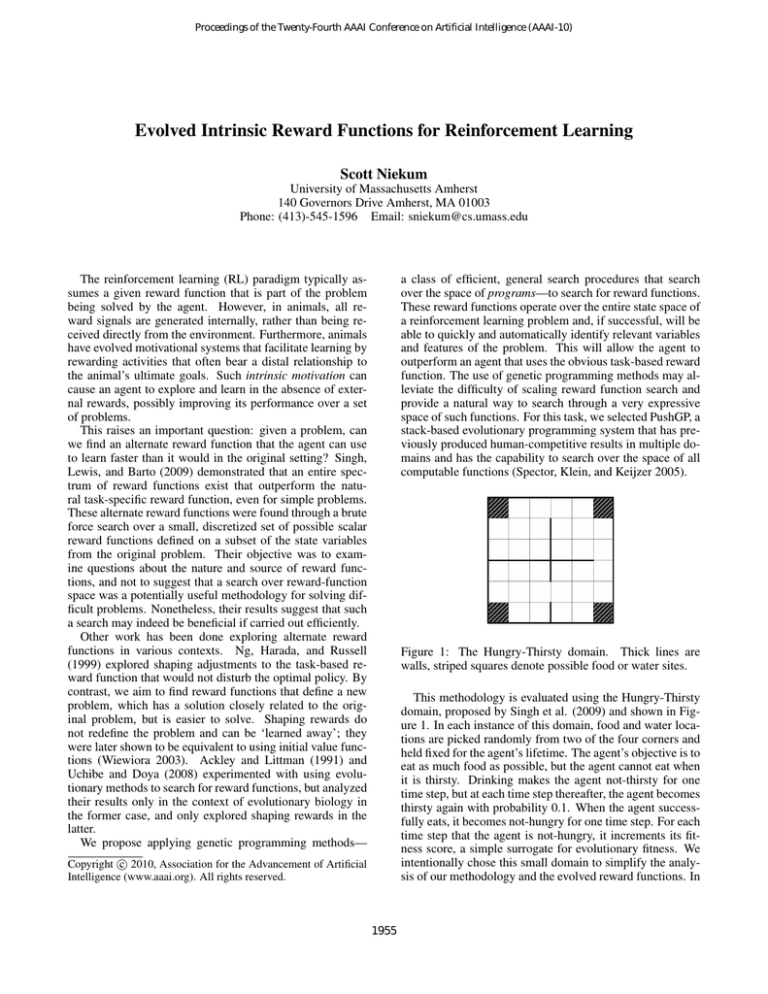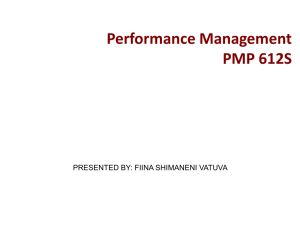
Proceedings of the Twenty-Fourth AAAI Conference on Artificial Intelligence (AAAI-10)
Evolved Intrinsic Reward Functions for Reinforcement Learning
Scott Niekum
University of Massachusetts Amherst
140 Governors Drive Amherst, MA 01003
Phone: (413)-545-1596 Email: sniekum@cs.umass.edu
The reinforcement learning (RL) paradigm typically assumes a given reward function that is part of the problem
being solved by the agent. However, in animals, all reward signals are generated internally, rather than being received directly from the environment. Furthermore, animals
have evolved motivational systems that facilitate learning by
rewarding activities that often bear a distal relationship to
the animal’s ultimate goals. Such intrinsic motivation can
cause an agent to explore and learn in the absence of external rewards, possibly improving its performance over a set
of problems.
This raises an important question: given a problem, can
we find an alternate reward function that the agent can use
to learn faster than it would in the original setting? Singh,
Lewis, and Barto (2009) demonstrated that an entire spectrum of reward functions exist that outperform the natural task-specific reward function, even for simple problems.
These alternate reward functions were found through a brute
force search over a small, discretized set of possible scalar
reward functions defined on a subset of the state variables
from the original problem. Their objective was to examine questions about the nature and source of reward functions, and not to suggest that a search over reward-function
space was a potentially useful methodology for solving difficult problems. Nonetheless, their results suggest that such
a search may indeed be beneficial if carried out efficiently.
Other work has been done exploring alternate reward
functions in various contexts. Ng, Harada, and Russell
(1999) explored shaping adjustments to the task-based reward function that would not disturb the optimal policy. By
contrast, we aim to find reward functions that define a new
problem, which has a solution closely related to the original problem, but is easier to solve. Shaping rewards do
not redefine the problem and can be ‘learned away’; they
were later shown to be equivalent to using initial value functions (Wiewiora 2003). Ackley and Littman (1991) and
Uchibe and Doya (2008) experimented with using evolutionary methods to search for reward functions, but analyzed
their results only in the context of evolutionary biology in
the former case, and only explored shaping rewards in the
latter.
We propose applying genetic programming methods—
a class of efficient, general search procedures that search
over the space of programs—to search for reward functions.
These reward functions operate over the entire state space of
a reinforcement learning problem and, if successful, will be
able to quickly and automatically identify relevant variables
and features of the problem. This will allow the agent to
outperform an agent that uses the obvious task-based reward
function. The use of genetic programming methods may alleviate the difficulty of scaling reward function search and
provide a natural way to search through a very expressive
space of such functions. For this task, we selected PushGP, a
stack-based evolutionary programming system that has previously produced human-competitive results in multiple domains and has the capability to search over the space of all
computable functions (Spector, Klein, and Keijzer 2005).
Figure 1: The Hungry-Thirsty domain. Thick lines are
walls, striped squares denote possible food or water sites.
This methodology is evaluated using the Hungry-Thirsty
domain, proposed by Singh et al. (2009) and shown in Figure 1. In each instance of this domain, food and water locations are picked randomly from two of the four corners and
held fixed for the agent’s lifetime. The agent’s objective is to
eat as much food as possible, but the agent cannot eat when
it is thirsty. Drinking makes the agent not-thirsty for one
time step, but at each time step thereafter, the agent becomes
thirsty again with probability 0.1. When the agent successfully eats, it becomes not-hungry for one time step. For each
time step that the agent is not-hungry, it increments its fitness score, a simple surrogate for evolutionary fitness. We
intentionally chose this small domain to simplify the analysis of our methodology and the evolved reward functions. In
c 2010, Association for the Advancement of Artificial
Copyright Intelligence (www.aaai.org). All rights reserved.
1955
Figure 2: Agent fitness (left) and evolutionary progress (right) over a distribution of environments.
our experiments, generations of agents are evaluated based
on their fitness across a distribution of environments within
this domain. Thus, a reward function emerges from the evolutionary process that maximizes an agent’s fitness across
this distribution of environments, capturing the most salient
common features.
Early results in the Hungry-Thirsty domain suggest that
PushGP is a promising system for efficiently searching for
reward functions. The left panel of Figure 2 compares the
cumulative fitness over an agent’s lifetime when using the
fitness-based reward, the best brute force search reward from
Singh et al. (2009), and rewards evolved using PushGP. In
the two variable case, the evolved reward function was given
as input the hunger and thirst status of the agent, the same
two state variables that the brute force method was given.
Here, the evolved function performs better; the evolutionary search did not have to search over a discretized space,
and thereby found a more refined solution. In the four variable case, we provided the reward function with two additional state variables, the agent’s X and Y position, and the
evolutionary process produced a slightly better reward function. At the very least, this shows that evolution can extract
salient features of a problem, even when searching over a
very large space of functions, affording better performance
than the simple brute force method.
The right panel of Figure 2 shows the fitness of the best
reward function evaluated so far as a function of time during
the evolutionary process. Despite the fact that adding additional relevant variables significantly increases the size of
the search space, we see that the four variable curve only
lags behind the two variable curve until around the tenth
generation, and then shows better performance thereafter. In
the other two cases, we added additional ‘distractor’ variables (two and four, respectively) that were uniformly distributed integers between 0 and 4. It appears that evolutionary search quickly learned to ignore these irrelevant variables, as evolutionary progress slowed relatively little with
their addition. This suggests that evolutionary methods such
as this may generalize well to larger, high-dimensional problems.
Alternate reward functions can improve the learning
speed and fitness of agents in a domain, but they may also
have more powerful uses in the future. As mentioned earlier, a properly evolved reward function captures the common features across environments that the agent faces. Thus,
such a reward function may be able to aid an agent in
autonomous skill identification and learning, allowing the
agent to hierarchically break down and solve much larger
problems than are currently feasible; it may also be able to
capture the similarities across a collection of tasks and thus
facilitate transfer.
Acknowledgements
This work was done under the supervision of professors Andrew Barto and Lee Spector.
References
Ackley, D., and Littman, M. 1991. Interactions between learning
and evolution. In Artificial Life II. SFI Studies in the Sciences of
Complexity.
Ng, A.; Harada, D.; and Russell, S. 1999. Policy invariance under
reward transformations: theory and application to reward shaping.
In Proceedings of the 16th International Conference on Machine
Learning, 278–287.
Singh, S.; Lewis, R.; and Barto, A. 2009. Where do rewards
come from? In Proceedings of the 31st Annual Conference of the
Cognitive Science Society, 2601–2606.
Spector, L.; Klein, J.; and Keijzer, M. 2005. The push3 execution
stack and the evolution of control. In GECCO 2005: Proceedings
of the 2005 conference on Genetic and evolutionary computation,
volume 2, 1689–1696.
Uchibe, E., and Doya, K. 2008. Finding intrinsic rewards by embodied evolution and constrained reinforcement learning. Neural
Networks 21(10):1447–1455.
Wiewiora, E. 2003. Potential-based shaping and Q-value initialization are equivalent. Journal of Artificial Intelligence Research
19:205–208.
1956





